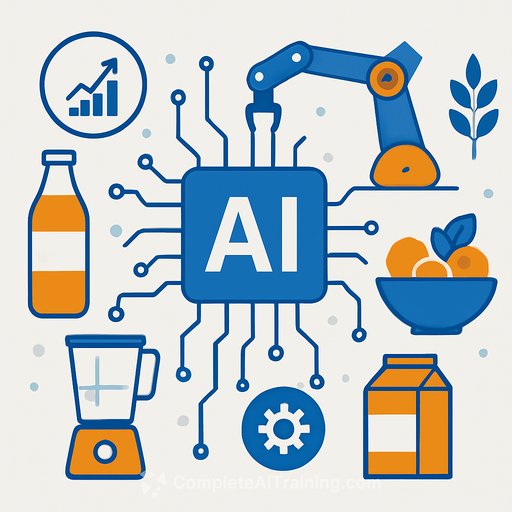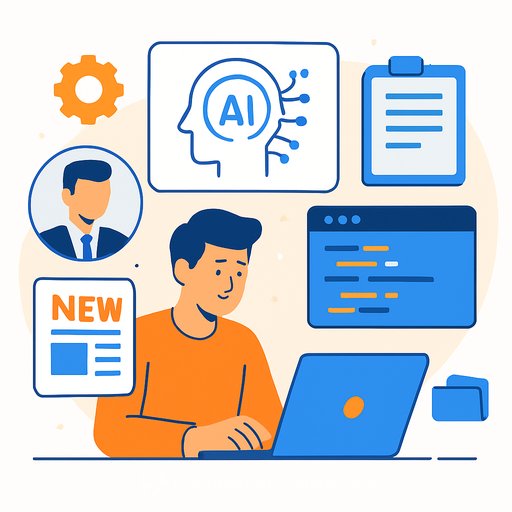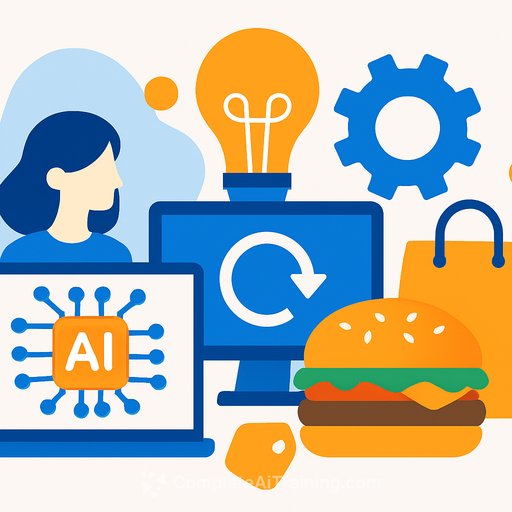AI in Food & Beverage: A Product Team's Guide to the 2025-2030 Market
The market for AI in food and beverage is set to grow from an estimated $10.8 billion in 2025 to $50.6 billion by 2030 (29.6% CAGR). Adoption is moving from trials into daily operations, and the winners are the teams shipping targeted use cases with clear ROI.
A new market report provides a structured view of where the money is going, which technologies matter, and how leading companies are building. Here's the signal you need as you plan your roadmap.
Market at a glance
- Scope: Global revenue estimates for 2025-2030, with 2024 as the baseline year.
- Size: $10.8B (2025) to $50.6B (2030), 29.6% CAGR.
- Focus: Market drivers, restraints, opportunities; vendor rankings; company profiles; segment and regional breakdowns.
- Length: 58 pages.
What's driving adoption
- Food safety and quality: Automated inspection and anomaly detection reduce recalls and audit risk.
- Operational efficiency: Vision systems, predictive maintenance, and scheduling cut downtime and waste.
- Product development: AI accelerates formulation, sensory prediction, and concept testing.
Constraints are real: upfront system cost and data security concerns. The biggest near-term opportunities are demand forecasting and inventory optimization, helped by growing investment and better off-the-shelf tools.
Where AI is paying off (by application)
- Food safety and quality control: Vision-based checks for contaminants, fill levels, and labeling accuracy.
- Marketing and consumer insights: Demand sensing, price elasticity modeling, and preference clustering.
- Production and packaging: Line monitoring, predictive maintenance, and schedule optimization.
- Food sorting: Automated grading by size, color, and defects to improve yield and consistency.
- Other: Supplier risk scoring, energy optimization, and sustainability reporting.
The tech stack that shows up most
- Machine learning: Forecasting, classification, anomaly detection, formulation modeling.
- Computer vision: Quality inspection, sorting, packaging verification.
- Robotics and automation: Pick-and-place, palletizing, and safer repetitive tasks.
- Natural language processing: Knowledge retrieval, call center assist, and unstructured feedback mining.
Who's adopting
- Food processing: Safety, yield, and line efficiency are the core wins.
- Beverage: Packaging QA, predictive maintenance, and demand planning.
- Retailers: Assortment, pricing, and fresh inventory management.
- Others: Foodservice and distribution with routing and labor planning.
Field examples to learn from
- Mackmyra using Microsoft technologies for smarter production decisions.
- Kerry applying IBM Watson to accelerate R&D and insights.
- Starbucks deploying Green Dot Assist to support store operations and staff.
- Coca-Cola Andina using a predictive system developed with Coderio.
- Mars advancing innovation with generative AI in product development.
Regional view
- North America, Europe: Earlier adoption and tighter compliance requirements push investment.
- Asia-Pacific: Fast growth fueled by manufacturing scale and retail digitization.
- South America, Middle East & Africa: Select high-ROI use cases, often in processing and logistics.
Vendors to know
The report covers the competitive field and ranks leading providers, including ABB, Adlink Technology, IBM, Rockwell Automation, Sesotec, Siemens, Tomra Systems, and others. Expect offerings to cluster around vision inspection, robotics, data platforms, and industry services. Shortlist based on integration effort, model transparency, and uptime guarantees-not just demo accuracy.
90-day product playbook
- Pick two use cases: One quality (e.g., label verification) and one planning (e.g., SKU-level demand).
- Audit the data: Define sources, latency, labeling needs, and ground truth plan.
- Prototype fast: Use existing cameras/PLCs where possible; target a 6-8 week pilot.
- Decide metrics early: For quality: false positives/negatives, defects per million. For planning: forecast error (MAPE), stockouts, waste.
- Close the loop: Route model outputs into actual decisions-stoppages, rework bins, order plans.
- Scale: Build a rollout template: hardware spec, SOPs, retraining triggers, and a support model.
Risk checklist
- Data security: Segment networks, control supplier access, and review vendor data retention policies.
- Model drift: Set alerts on quality yield and forecast error; schedule periodic revalidation.
- Compliance: Map AI use to HACCP and ISO 22000 checks; document decisions and overrides. See the FDA's New Era of Smarter Food Safety initiative for context here.
- Worker safety and change: Update training and signage; involve operators early to reduce resistance.
What this means for product teams
Keep scope tight, wire into existing controls, and prove value with line metrics the plant trusts. Favor tools that work with your cameras, PLCs, and MES, and reduce the number of custom components your team must maintain.
If you need structured upskilling for product and ops teams, see curated AI pathways by job role here.
Get the full report
For detailed revenue models, segment sizing, vendor rankings, and company profiles, view the report: AI in the Food & Beverage Industry: Global Markets.
Your membership also unlocks:






